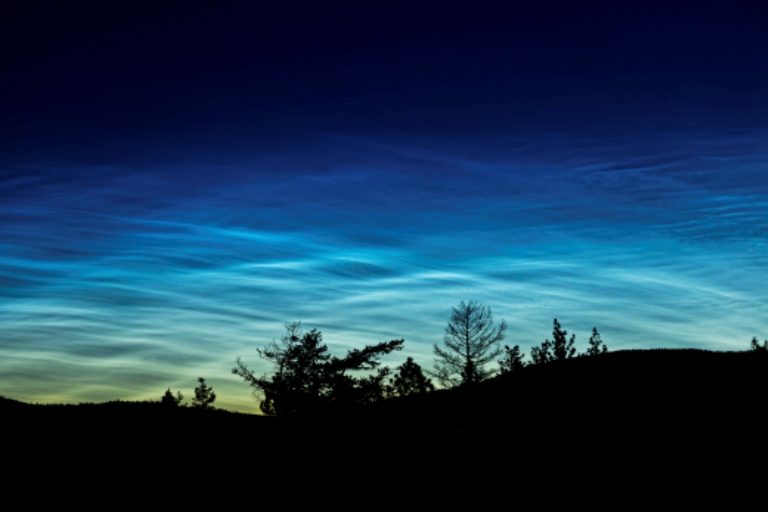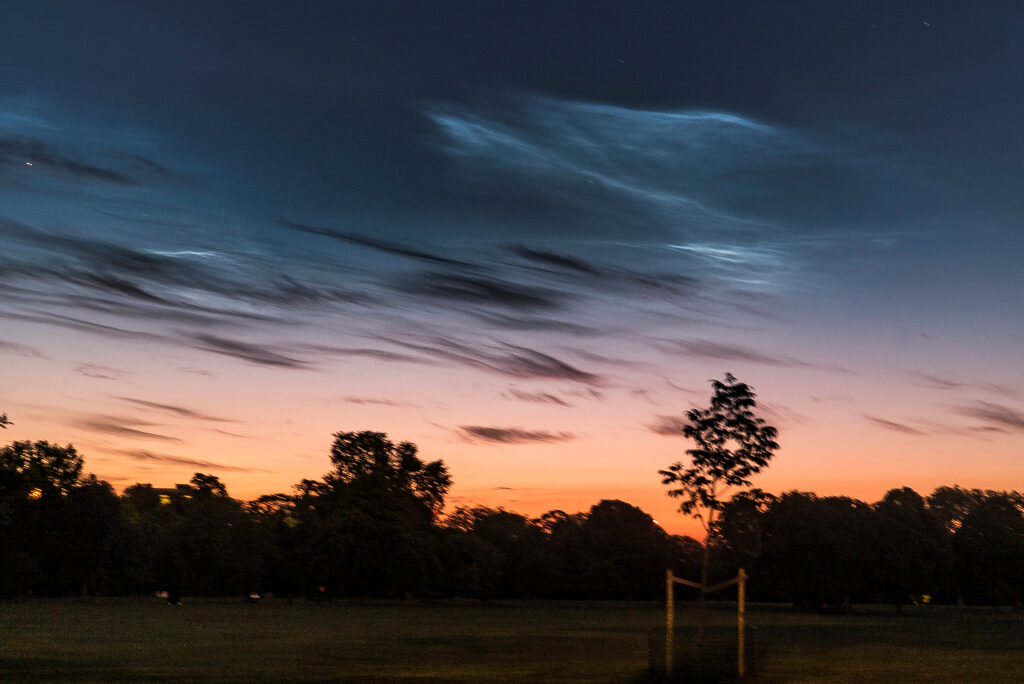
© Debra CeravoloNoctilucent clouds over Osoyoos, British Columbia, on June 1, 2020.
Noctilucent clouds (NLCs) are spilling across the Arctic Circle and descending to mid-latitudes. "During morning twilight, the north was unusually bright with beautiful blue-green clouds," reports Debra Ceravolo of Osoyoos, BC, Canada.
"It is rare to see them here at 49 degrees latitude."NLCs are Earth's highest clouds. Seeded by meteoroids, they float at the edge of space more than 80 km above the ground. The clouds form when summertime wisps of water vapor rise up to
the mesosphere, allowing water to crystallize around specks of
meteor smoke.
Last summer, noctilucent clouds spread as far south as Los Angeles and Las Vegas, setting records for low-latitude sightings. It could happen again this summer. The clouds are heading south and already within 2 degrees of Seattle in the continental USA.
It's getting cold in the mesosphere. Very cold. "At polar latitudes (60N-80N) temperatures have been
breaking 14-year records in the last few days," says Lynn Harvey of the University of Colorado Laboratory for Atmospheric and Space Physics.
This development is causing noctilucent clouds (NLCs) to spill out of the Arctic to middle latitudes."I've been waiting for years to see NLCs, and finally it happened!" reports Phil Halpert from London, England, on June 7th. He noticed their electric-blue ripples
over local rooftops, then rushed out to photograph them in open sky over Clissold Park.

© Phil HalpertNoctilucent clouds snapped above Clissold Park, London, England, on June 7th.
he says.
NLCs are Earth's highest clouds.
Seeded by meteoroids, they float at the edge of space 83 km above the ground. The clouds form when summertime wisps of water vapor rise up to
the mesosphere, allowing water to crystallize around specks of
meteor smoke.
Usually they are best seen after the summer solstice, but this year they are getting an early start.What's happening? To find out, Harvey has been looking at data from NASA's Microwave Limb Sounder (MLS), which can sense conditions 83 km high where NLCs form. "These plots show that 2020 is shaping up to be a very cold and wet year," she says.
"Temperatures, in particular, are
very cold," she says. "In fact, mid-latitude (35N-55N) temperatures in late May (DOY 142-148) were
the coldest of the AIM record"--that is, since 2007 when NASA's AIM spacecraft began monitoring noctilucent clouds.
Last summer, NLCs spread as far south as Los Angeles and Las Vegas, setting records for low-latitude sightings. The growing chill today suggests this summer could be just as good--or maybe even better. In fact, the first sightings in the continental USA (
Washington and
Minnesota) have already happened.
Observing tips: The best time to look for NLCs is during the hours after sunset (or before sunrise) when the sun is more than 6 degrees below the horizon:
diagram. If you see electric-blue tendrils spreading across the sky, take a picture and
submit it here.



Comment: The cold temperatures being recorded are interesting, but the other key element in seeding these 'clouds' is meteor/comet dust. Which suggests that a lot more of that is in our atmosphere these days...
See also: